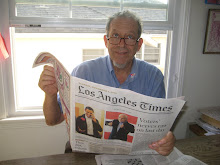CRACK
The crack in everything that lets in light
is also one where darkness tries to enter;
it may distract you if it is not right
where you should always focus, in the center,
because the light is best when it is shining
not everywhere where there may be a crack,
but in places deep where we should be mining
the darkness for the light it does not lack.
Cristina Nehring reviews a number of books on Heloise and Abelard in The NY Times Book Review, February 13, 2005 (“Love Hurts”) and concludes:
It is Heloise's tact and generosity that allow the dialogue to continue and even attain exemplary dimensions. Seeing that her beloved is no longer capable of the language of passion, she smothers her love song (''the loss,'' as Burge states, ''is history's'') and addresses him on the only terms he still knows and values. Like the star student she once was, she begins to quiz him on every biblical, monastic and moral question she can think of. In doing so, she inspires much of the most valuable -- and satisfying -- work of Abelard's life. Disdained by his own monks as well as by the Vatican (he was twice condemned for heresy), he found an enthusiastic audience in Heloise and her nuns. It is for Heloise that he undertakes what one scholar has called ''the most substantial writings of the 12th century on women's place in Christianity''; it is for Heloise that he writes countless sermons, hymns and disquisitions on spiritual themes. Heloise's convent becomes, in some sense, the couple's joint project, their spiritual child. Their cooperation struck onlookers as a dazzling example of friendship between a man and a woman.
If Heloise didn't get what she most wanted from Abelard, she got the very best he had to give. His reflections, his confidences and his final, all-important confession were addressed to her; his most urgent worldly plea was to be buried where she would be near him. Is their story a fraud because Abelard, as Mews has written, was ''tagging along behind'' Heloise in matters of the heart?
The love stories that touch us most deeply are punctuated by human frailty. Look at them up close and you see the fault lines, compromises and anticlimaxes. At the beginning of Shakespeare's play, Romeo is just as intemperately in love with a girl called Rosaline as he is later with Juliet. Tristan and Isolde's passion could well be the fruit of substance abuse, of a love potion they drank unknowingly. And Abelard and Heloise? They weren't equally strong or passionate or generous. Still, they put their frailties together and begat a perfect myth, as well as something perhaps even more precious -- a surprising, splendid, fractured reality. ''There is a crack,'' the Leonard Cohen lyric goes, ''a crack in everything: that's how the light gets in.''
2/13/05
Thursday, February 18, 2010
Subscribe to:
Post Comments (Atom)


No comments:
Post a Comment